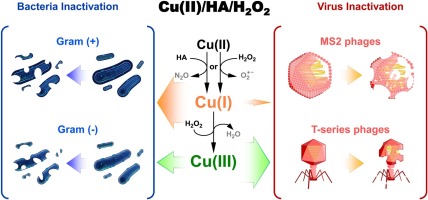Publication
Advanced Redox Technology Lab
Publication
Advanced Redox Technology Lab
Journal papers
The microbial inactivation by cupric ion (Cu(II)) in combination with hydrogen peroxide (H2O2) and hydroxylamine (HA) was investigated for twelve different microorganisms (five Gram-negative bacteria, three Gram-positive bacteria, and four bacteriophages). The inactivation efficacy, protein oxidation, and RNA (or DNA) damage were monitored during and after treatment by Cu(II), Cu(II)/HA, Cu(II)/H2O2 and Cu(II)/HA/H2O2. The rate of microbial inactivation by the (combined) microbicides generally increased in the order of Cu(II) < Cu(II)/H2O2 < Cu(II)/HA < Cu(II)/HA/H2O2; Cu(II)/HA/H2O2 resulted in 0.18–0.31, 0.10–0.18, and 0.55–3.83 log inactivation/min for Gram-negative bacteria, Gram-positive bacteria, and bacteriophages, respectively. The degrees of protein oxidation and RNA (or DNA) damage increased in the order of Cu(II) < Cu(II)/HA < Cu(II)/H2O2 < Cu(II)/HA/H2O2. In particular, Cu(II)/HA/H2O2 led to exceptionally fast inactivation of the viruses. Gram-positive bacteria tended to show higher resistance to microbicides than other microbial species. The microbicidal effects of the combined microbicides on the target microorganisms were explained by the roles of Cu(I) and Cu(III) generated by the redox reactions of Cu(II) with H2O2, HA, and oxygen. Major findings of this study indicate that Cu(II)-based combined microbicides are promising disinfectants for different waters contaminated by pathogenic microorganisms.
